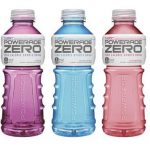Schools & Full Calorie Beverages
August 16, 2012
Journal Article Validates Beverage Industry’s Success in Removing Full-Calorie Soft Drinks from Schools Nationwide
NEW RESEARCH STUDY SHOWS A 90 PERCENT REDUCTION IN BEVERAGE CALORIES SHIPPED TO SCHOOLS SINCE 2004
 WASHINGTON, D.C. – Research published today in the American Journal of Public Health confirms that the beverage industry has successfully removed full-calorie soft drinks from schools nationwide and replaced them with lower-calorie, smaller-portion options. Through this effort, The Coca-Cola Company, Dr Pepper Snapple Group, PepsiCo and their respective bottlers have reduced beverage calories shipped to schools by a dramatic 90 percent between 2004 and the end of the 2009-2010 school year. This updated data builds on the industry’s previous 2010 announcement of its successful implementation of the School Beverage Guidelines developed with the Alliance for a Healthier Generation.
WASHINGTON, D.C. – Research published today in the American Journal of Public Health confirms that the beverage industry has successfully removed full-calorie soft drinks from schools nationwide and replaced them with lower-calorie, smaller-portion options. Through this effort, The Coca-Cola Company, Dr Pepper Snapple Group, PepsiCo and their respective bottlers have reduced beverage calories shipped to schools by a dramatic 90 percent between 2004 and the end of the 2009-2010 school year. This updated data builds on the industry’s previous 2010 announcement of its successful implementation of the School Beverage Guidelines developed with the Alliance for a Healthier Generation.
“The beverage industry voluntarily agreed to make these changes in schools across America, and our independent monitoring shows that it has stood by that commitment,” said study co-author Dr. Robert Wescott, president, Keybridge Research LLC.”
“It is clear that industry self-regulation can be a valuable tool in improving public health outcomes, especially when coupled with a transparent and independent monitoring process.”
Under the voluntary Alliance School Beverage Guidelines, the participating companies worked with their school partners to remove full-calorie soft drinks from all schools and replace them with approved drinks, specifically bottled water, low-fat milk and 100 percent juice (or 100 percent juice plus water) in elementary and middle schools, with the addition of lower-calorie and portion-controlled beverages in high schools.
“Our industry is committed to the health and wellness of our nation’s children, and we are proud of what we have accomplished through the School Beverage Guidelines with the Alliance for a Healthier Generation and our school partners,” Susan K. Neely, president and CEO of the American Beverage Association, said. “The guidelines are a national standard that is in place and working, and we support their adoption as part of the federal regulations for competitive foods in schools.”
The peer-reviewed analysis by Dr. Wescott and co-authors Brendan Fitzpatrick and Elizabeth Phillips, entitled “Industry Self-Regulation to Improve Student Health: Quantifying Changes in Beverage Shipments to Schools,” measured bottler shipments to schools via detailed company data reports. The authors’ firm, Keybridge Research LLC, also prepared the previous progress reports on the School Beverage Guidelines implementation. The report shows that industry continues to deliver in schools across America:
Full-calorie soft drinks have been removed.
Shipments of full-calorie soft drinks to schools have declined by 97 percent between 2004, the last comprehensive data available prior to the agreement, and the end of the 2009-2010 school year.
Calories available from beverages in schools have been cut dramatically. In fact, 90 percent fewer beverage calories were shipped to schools during that time.
In May 2006, the Alliance for a Healthier Generation worked with representatives of The Coca-Cola Company, Dr Pepper Snapple Group, PepsiCo and the American Beverage Association to establish School Beverage Guidelines that limit portion sizes and reduce the number of beverage calories available to children during the school day and extended school day. The industry committed to complete implementation of the guidelines by the beginning of the 2009-2010 school year.
Dr. Wescott and his co-authors are available for media interviews. In addition, their paper is available from the American Journal of Public Health.
See article on the American Beverage Association article.